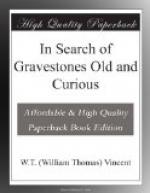As companions to this I present a pair of dwarf stones with full-relief heads of seraphs and cherubs—an agreeable change—from the same county.
Fig. 55.—At Ripley.
“To Sarah wife of Henry Bower,
died 1741.
To Henry Bower, died March 23rd, 1758.”
The Rector of the parish passed as I was sketching these interesting objects, and was surprised to find that he had anything so unusual in his churchyard.
[Illustration: Fig. 52. Lydd.]
[Illustration: Fig. 53. Bermondsey.]
[Illustration: Fig. 54. Richmond.]
[Illustration: Fig. 55. Ripley.]
[Illustration: Fig. 56. Cobham.]
[Illustration: Fig. 57. Barnes.]
CHAPTER IV.
Professional gravestones.
It is more than likely that somewhere will be found a pictorial accompaniment to the verse which has been often used as an epitaph for a village blacksmith. I have met with the lines in two or three versions, of which the following, copied in the churchyard at Aberystwith, appears to be the most complete:
“My sledge and hammer lie reclined;
My bellows too have lost their wind;
My fire extinct, my forge decay’d,
And in the dust my vice is laid.
My coal is spent, my iron’s gone;
My nails are drove, my worck is done.”
There are many instances in which the implements of his craft are depicted upon an artizan’s tomb; these also for the most part being of the eighteenth century. In the churchyard at Cobham, a village made famous by the Posthumous Papers of the Pickwick Club, is a gravestone recording the death of a carpenter, having at the head a shield bearing three compasses to serve as his crest, and under it the usual tools of his trade—square, mallet, compasses, wedge, saw, chisel, hammer, gimlet, plane, and two-foot rule.
Fig. 56.—At Cobham, Kent.
“To Richard Gransden, carpenter,
died 13th
March, 1760.”
This one may serve as a fair sample of all the trade memorials to which carpenters have been, before all classes of mechanics, the most prone. The carvings bear the same strong resemblance to each other that we find in other series of gravestones, but have occasional variations, as in the following specimen, which mixes up somewhat grotesquely the emblems of death and eternity with the mundane instruments of skill and labour, including therein a coffin lid to shew maybe that the man, besides being a carpenter, was also an undertaker.
Fig. 57.—At Barnes.
“To Henry Mitchell, died 1724, aged 72 years.”
It was only to be expected that the prominent agriculturists of rural districts would be figuratively represented on their gravestones, and this will be found to be the case in a number of instances. The following illustration is from the churchyard of Frindsbury, a short distance out of Rochester and on the edge of the Medway meadows.




